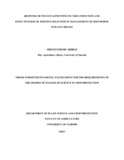| dc.description.abstract | Potato seed degeneration resulting from accumulation of seed borne viral pathogens in seed-tubers is a major challenge limiting optimal yields in potato growing areas around the world especially in the tropics. A study was carried out at the Kabete Field Station, University of Nairobi to determine response of potato genotypes to natural virus infection in the field and to assess effectiveness of positive selection on the health of seed potato tubers with regards to potato viruses. Sprouted seed potato tubers of twelve genotypes harvested from Field Generation Two (FG2) were planted and the crop was subjected to natural virus infection in the field for two seasons (Field Generation Three (FG3) and Field Generation Four (FG4)). These genotypes consist of five commercial varieties (Tigoni, Kenya Mpya, Shangi, Asante and Sherekea) and seven clones (398190.200, 300046.22, 393371.157, 393077.159, 392797.22, 398098.65 and 397073.7) sourced from International Potato Center (CIP). Fungal diseases on the crop were controlled using appropriate fungicides with no control of insects to facilitate high vector movement. Ten weeks after planting of tubers from FG2, plants with no virus symptoms were pegged in each plot and regular checking to de-peg those with newly developed disease symptoms was done weekly until crop maturity. Symptomatic and asymptomatic plants were harvested separately; medium size (30-60 mm) and apparently healthy looking tubers were selected from each plot. These tubers from FG3 were stored in an insect proof diffused light store for two months to sprout. The sprouted tubers from positively selected plants were used as seed stocks for Positive Selection (PS) and tubers harvested from visually diseased plants were used as seed stock for Random Seed Selection (RSS) for FG4. At the end of FG4, 100 medium size and apparently healthy looking tubers were collected randomly from each genotype from both RSS and PS plots. These tubers were sprouted and tested for presence of six major potato
xiii
viruses using DAS-ELISA. Data was collected on percent seed emergence, disease incidence, plant height, numbers of tubers and total yield for each genotype in both FG3 and FG4. The study revealed a varied percent emergence, virus incidence, plant heights, number of tubers per hill and yield (t/ha) among the twelve genotypes from FG3 to FG4. High percent emergence, low disease incidence, higher plant heights, number of tubers per hill and yields were recorded in FG3 compared to FG4. Four potato viruses; Potato leaf roll virus (PLRV), Potato virus S (PVS), Potato virus M (PVM) and Potato Virus Y (PVY) were detected infecting tested potato tubers from FG4 either as single infection or as multiple infections. Potato Virus S (PVS) was the most dominant virus (67%) followed by PVY (20%), PLRV (12%) and PVM (7%) while PVA and PVX were not detected in any of the tested tubers. Use of PS reduced increase in virus disease incidence by 3 to 10%, increased plant height by 1 to 14%, number of tubers by 9 to 41% and yield by 4 to 56% depending on genotypes. ELISA results revealed Potato Virus S (PVS) as the most predominant virus followed by Potato Virus Y (PVY) and Potato Leaf Roll Virus (PLRV) in both RSS and PS plots, while Potato Virus M (PVM) was only detected in samples from RSS plots. Four clones; 397073.7, 398190.200, 393371.157 and 392797.22 were found tolerant to natural virus infections compared to five commercial varieties and other three clones in FG4 based on the yields obtained. Based on the results positive selection and use of resistant and or tolerant varieties can be used to manage seed borne potato viruses to some extent by farmers who produce their own seeds. | en_US |



